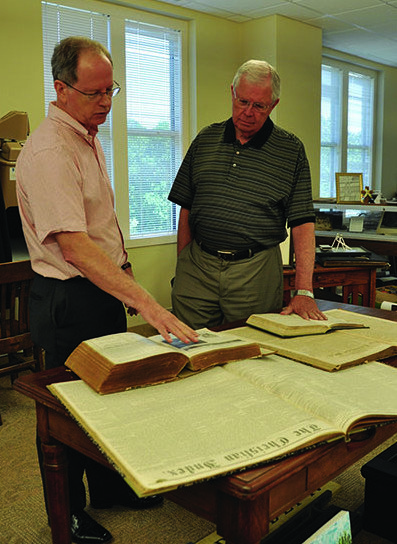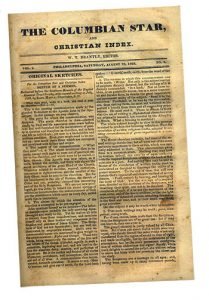 GBC Archivist Charles Jones, left, and Index Editor Gerald Harris, right, look over a variety of sizes of The Index during the past two centuries. The paper frequently changed size and format due to mailing costs and availability of newsprint. During the Civil War it advertised it was seeking rags to add to the newsprint to provide a better quality paper. JOE WESTBURY/Index
GBC Archivist Charles Jones, left, and Index Editor Gerald Harris, right, look over a variety of sizes of The Index during the past two centuries. The paper frequently changed size and format due to mailing costs and availability of newsprint. During the Civil War it advertised it was seeking rags to add to the newsprint to provide a better quality paper. JOE WESTBURY/IndexIf there are two things that can be said about The Christian Index, it’s that it has always been changing with the times … and that it’s always been about missions. In fact, “missionary intelligence” – or reports from the field as it was known at its founding – is the reason the nation’s oldest continuously published Christian newspaper came into existence in 1822.
Continuing with that longstanding history of change and adaptability, The Index will transition primarily to an online presence on January 1, 2016. Bowing to the pressures of an increasingly difficult economic climate with rising production and distribution costs – coupled with declining revenue from circulation and advertising – The Index will produce its final biweekly print edition on Dec. 24.
But that doesn’t mean it will cease publishing. It will simply move to the web with a never-ending news cycle no longer tied to print deadlines and ever-increasing mailing costs. It will also be a free product with no charge for online access.
This shift will free up Cooperative Program funds that will be redirected toward evangelism and church planting efforts in Georgia and far beyond its borders. The move will enable The Index to remain true to its original calling of providing missions support through stories that encourage, motivate, and inspire its readers to greater sacrifice.
In fact, when one of Georgia Baptists’ first missionary couples, Edward A. and Elizabeth Stevens from Liberty County’s Sunbury near Savannah, sailed for Burma in 1837 they cited “missionary intelligence” as one of the primary reasons they were responding to God’s call on their lives.
Those kind of life-changing stories from the field are the foundational reason The Index was born and why it continues today.
Last year the newspaper announced a major shift to the Internet as it extended its online presence beyond desktop computers to a variety of platforms such as smart phones and tablets. This final transition will solidify its presence 16 years into the new century as a 24/7 news service with a continuous posting of stories as they occur.
Readers will no longer have to wait a week or two between publication dates to read news that, in some instances, have lost their timeliness and are more history than news.
In the last two decades The Index, due to rising costs, moved from a weekly with 12-16 pages to a bi-monthly publication. That every-other-week shift, which occurred in the Fall of 2000, resulted in increasing pages to an average of 16-24 pages. But financial pressures – which resulted in mailing costs far exceeding printing costs – have once again scaled the page count back to 12-16.
With all these changes the future of The Index, as its past, will remain focused on missions, primarily in Georgia.
The Index’s history begins with minister Luther Rice, one of evangelicalism’s prominent early missions supporters.
In the early 1800s Rice and Adoniram Judson, Congregationalists, were part of a movement that gathered to pray for missions. They eventually left as America’s first foreign missionaries, intending to serve alongside English Baptist missionary William Cary in India. Upon arrival on separate ships – after having been convicted of baptism by immersion rather than sprinkling as Congregationalists practiced – they were baptized on the field. Thus their embracing of Baptist doctrine required them to resign from the Congregational Mission Board.
In 1812 the British, because of their war with America, did not want U.S. missionaries serving in their territory in India. Cary, an Englishman, remained but Rice and Judson slipped into Burma to serve. Rice decided to return to the States to formally resign and attempt to raise Baptist support for their mission in Burma.
At that time Baptists in the States cooperated loosely through a network of “associations.” Since the modern missionary movement was in its infancy there were no missionaries to support so meetings consisted of doctrinal study and fellowship.
Rice was about to change all that.
Cary, an English Baptist, was the most prominent missionary in the States and received strong spiritual but limited financial support from Baptists. As stories of Judson’s success on the foreign field – through Rice’s efforts – began to circulate he soon rose to equal prominence.
 The Index indirectly traces its heritage to The Latter Day Luminary, which was founded in Philadelphia in 1817.
The Index indirectly traces its heritage to The Latter Day Luminary, which was founded in Philadelphia in 1817.Rice began travelling extensively to organize a network of support among Baptists in America. He helped organize a meeting of messengers from those associations in 1814, which became the Triennial Convention. That group began meeting every three years to conduct limited business and provide support to both home and foreign missions.
With that background, it’s easier to understand why the times called for a national weekly publication to promote “missionary intelligence” – a publication that would become known as The Christian Index.
Its forerunner was The Latter Day Luminary, established in Philadelphia in 1817 as a quarterly focused on foreign missions. Shortly after its founding Rice purchased the Latter Day Luminary and moved it to Washington, D.C. in 1821, where he used it to promote missions as well as his newly founded educational institution, Columbian College.
The college was launched to provide general education for those desiring a college degree and theological education for missionaries. Rice then launched a newspaper called Columbian Star to promote the missions and the new college.
 The Christian Index name was first used by Editor W. T. Brantley to emphasize its distinctive Christian content. The Columbian Star was eventually dropped from the masthead.
The Christian Index name was first used by Editor W. T. Brantley to emphasize its distinctive Christian content. The Columbian Star was eventually dropped from the masthead.He eventually merged both into one publication known as The Latter Day Luminary and Columbian Star.
When Rice encountered financial problems he sold the Columbian Star to W.T. Brantley, pastor of First Baptist Church of Philadelphia and founding pastor of First Baptist Church of Augusta (where the SBC would later be organized in 1845).
In 1829 Brantley changed the name to The Columbian Star and Christian Index ... the first time the Index title was used. He stated he added the additional name to stress its Christian focus. Three years later, in 1833, he sold the publication to Jesse Mercer who moved it from Philadelphia to Washington, GA, and dropped Columbian Star from the masthead.
Thus, The Christian Index had come into its own as a newspaper dedicated to the spiritual and financial support of missionaries and Baptist higher education, specifically Mercer Manual Labor School in Penfield (later to be known as Mercer University).
Other Baptist state conventions began publishing Christian newspapers like The Index. Mercer continued publishing news on foreign and home missions but added a more Georgia-centric flavor to the paper.
In 1840 Mercer, in declining health, gave The Christian Index to the Georgia Baptist Convention. He died a little more than a year later and was buried at Penfield.
The state convention sold and repurchased The Index in the following years, requiring it for the final time in 1919 with funds raised as part of the $75 Million Campaign. The Index then became a publication dedicated entirely to encouraging Baptists to support their missionaries through a totally new unified approach launched in 1925. Known as the Cooperative Program, churches could pool their resources far more efficiently and provide a steady, dependable source of income to their missionaries.
The radical approach eliminated the old, ineffective competitive society approach to mission funding. It was an historic moment which The Index seized as a prominent advocate, thus realizing founder Luther Rice’s original dream of sustained missionary support.
And so the Cooperative Program remains to this day, with the addition of the Mission Georgia offering. Through the decades Georgia Baptists, due in part to stories that have appeared in The Index, have established themselves as one of the top supporters – and many times the number one supporter of the Cooperative Program – among all state conventions.
The Mission Georgia state missions offering now works alongside the Cooperative Program to bring the Gospel to the state beloved of Rice and Mercer. The state’s 7 million unchurched residents have become as viable a mission field as any in the world.
For nearly two centuries – since its founding in 1822 in downtown Washington, D.C. �� the paper has repeatedly changed size, location, content, and ownership. This move to an enhanced Internet presence will continue that commitment to missions support to an even greater audience worldwide.